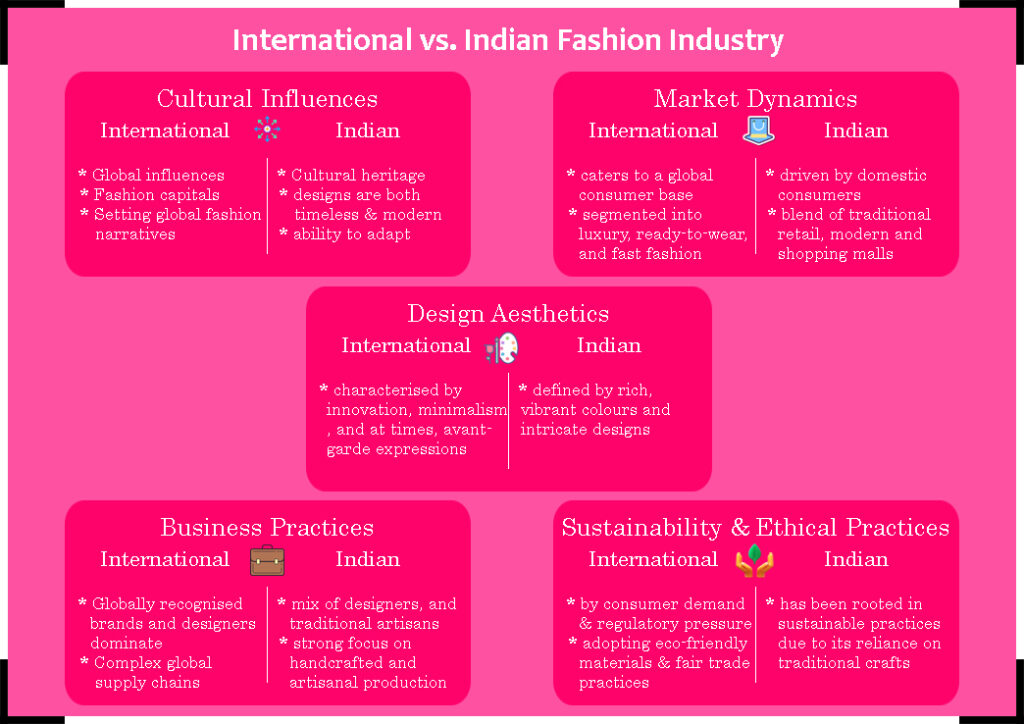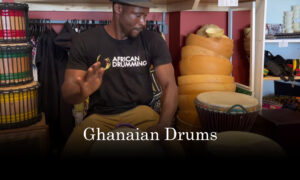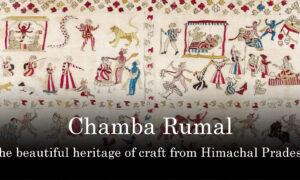Intoduction to International vs. Indian Fashion Industry
Fashion as a global phenomenon is a recent international event. Earlier fashion was a very regional development, every nation, every culture throughout history has developed their own fashion milestones, different aesthetics, design and business systems etc. Based on this observation we will look at the 5 lenses to understand the differences when we talk about the International vs. Indian fashion industry.
In this blog we will unearth a tapestry of contrasts that define these two distinct yet interconnected worlds. In this exploration, we delve into the cultural influences, market dynamics, design aesthetics, business practices, and sustainability efforts that shape these two vibrant fashion landscapes. To understand the how these two are connected to yet are distinct from each other.
1. Cultural Influences
International Fashion Industry
The international fashion industry stands as a testament to globalisation’s unifying force. With influences spanning continents, it mirrors the diverse cultural inputs from Europe, America, Asia, and Africa. Fashion capitals such as Paris, Milan, New York, and London serve as the epicentres of global trends, driving a wide array of styles from haute couture to street fashion. The international arena is characterised by its innovative spirit and a relentless pursuit of newness, continually setting benchmarks for global fashion narratives.
Indian Fashion Industry
In contrast, the Indian fashion industry is deeply rooted in its rich cultural heritage. The influence of traditional Indian textiles, techniques, and regional diversity is paramount. From the vibrant sarees of the South to the intricate lehengas of the North, Indian fashion is a celebration of its cultural mosaic. Festivals and weddings play a pivotal role, driving the demand for elaborate and ornate designs that are both timeless and contemporary. The Indian fashion landscape is a testament to the country’s enduring traditions and its ability to adapt and innovate within its cultural framework.
2. Market Dynamics
International Fashion Industry
The international fashion market, vast and multifaceted, caters to a diverse and discerning global consumer base. The market is segmented into luxury, ready-to-wear, and fast fashion, each with its distinct characteristics and consumer demographics. High-end boutiques, department stores, and fast fashion retailers dominate the retail landscape, each contributing to the industry’s substantial economic footprint. The international market’s scale and diversity underscore its global influence and economic significance.
Indian Fashion Industry
The Indian fashion market, while rapidly growing, remains distinctively different from its international counterpart. Primarily driven by domestic consumers, the market is expanding its reach to international audiences, fueled by the diaspora and increasing global interest. The retail models in India are a blend of traditional retail, modern shopping malls, and burgeoning e-commerce platforms, reflecting the country’s economic and technological advancements. The Indian market’s evolution underscores its dynamic nature and potential for growth.

3. Design Aesthetics
International Fashion Industry
Design aesthetics in the international fashion industry are characterised by innovation, minimalism, and at times, avant-garde expressions. Fast-changing trends and seasonal collections, showcased at prominent fashion weeks, epitomise the industry’s forward-looking nature. The use of a wide range of materials, including sustainable and innovative fabrics, reflects the industry’s commitment to creativity and environmental consciousness.
Indian Fashion Industry
The Indian fashion industry’s design aesthetics are defined by rich, vibrant colours and intricate designs. With a deep respect for traditional patterns and motifs, Indian fashion trends evolve more gradually, maintaining a balance between heritage and modernity. Natural fibres like cotton and silk dominate, with a significant emphasis on sustainability and eco-friendly practices. The aesthetic sensibilities of Indian fashion are a harmonious blend of the past and the present, embodying the country’s cultural ethos.
4. Business Practices
International Fashion Industry
Globally recognised brands and designers dominate the international fashion industry, supported by extensive marketing and advertising strategies. Complex global supply chains emphasise efficiency and cost-effectiveness, reflecting the industry’s scale and operational sophistication. Major fashion weeks in Paris, Milan, New York, and London are pivotal events, setting global trends and showcasing the industry’s best.
Indian Fashion Industry
The Indian fashion industry, in contrast, features a mix of established designers, emerging talents, and traditional artisans. Localised supply chains with a strong focus on handcrafted and artisanal production highlight the industry’s unique value proposition. Indian fashion weeks in cities like Mumbai, Delhi, and Bangalore showcase a diverse range of designs, from traditional to contemporary, underscoring the industry’s versatility and creativity.
5. Sustainability and Ethical Practices
International Fashion Industry
Sustainability and ethical practices are increasingly becoming focal points in the international fashion industry. Driven by consumer demand and regulatory pressures, the industry is adopting eco-friendly materials, fair trade practices, and initiatives to reduce carbon footprints. These efforts reflect a growing awareness of environmental and social responsibilities.
Indian Fashion Industry
Historically, the Indian fashion industry has been rooted in sustainable practices due to its reliance on traditional craftsmanship. Today, there is a renewed focus on sustainability, with an emphasis on reviving traditional crafts, promoting handloom industries, and supporting local artisans. These initiatives not only preserve cultural heritage but also contribute to the global sustainability movement.
How these two worlds impact each other
The Indian fashion industry has significantly impacted the international fashion landscape through its revival of traditional crafts, textiles, and its vibrant aesthetics. Techniques such as handloom weaving, block printing, and intricate embroidery have gained international acclaim, leading to collaborations with renowned global designers and brands. Indian designers like Manish Arora, Sabyasachi Mukherjee, and Ritu Kumar have made notable contributions to the global fashion stage, blending traditional Indian styles with contemporary designs. This infusion of Indian elements has enriched global fashion narratives, bringing authenticity, craftsmanship, and a vibrant cultural richness that has been embraced by designers and fashion enthusiasts worldwide.
Conversely, the international fashion industry has profoundly influenced Indian fashion by introducing Western silhouettes, trends, and modern design philosophies. The adoption of Western styles, such as dresses, gowns, and tailored suits, has become increasingly prevalent in Indian fashion, reflecting a blend of global and local influences. Additionally, exposure to international fashion weeks, global marketing strategies, and advanced production techniques has driven innovation and expansion within the Indian fashion industry. This cross-cultural exchange has not only broadened the horizons of Indian designers but has also fostered a more dynamic and diverse fashion landscape in India, demonstrating the powerful interplay of global and local influences in shaping contemporary fashion.
Conclusion
It is now easy evident enough to say that these two phenomena that we call the international and Indian fashion industry are though distinct in their cultural roots and market dynamics, are united in their quest for creativity, innovation, and sustainability. As globalisation continues to influence both these sectors, the appreciation and understanding of their unique characteristics become ever more crucial. The interplay between tradition and modernity, local and global influences, defines the rich tapestry of the fashion world, offering a window into the cultural and economic narratives that shape our times.
If you think we have missed any important point that connects these two fashionverses then do let us know. Also let us know in the comments if you wish to read about any specific fashion subject.





























Pingback: 5 Elsa Schiaparelli : Best Italian Fashion Designer Series
Pingback: 5 Anita Dongre : Best Indian Fashion Designer Series